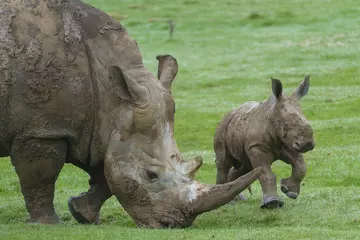
A one-month-old southern white rhino calf has shown his love for the great outdoors, after exploring his 21-acre paddock for the very first time.
Born on 2 October to mum Fahari, the baby boy has only just begun to venture out of his indoor cosy den, but took great pleasure getting down and dirty in the paddock’s muddy wallows – an upside of the drizzly November weather.

Rhino keeper Michael Hepher said: “It's been amazing to see our newest rhino calf tearing around the paddock with mum today, he’s well and truly found his feet!”
“He’s getting more confident each day and is getting more curious about the world around him. We've seen him chasing the antelope, and having great fun getting covered in mud, a favourite past-time of all our rhinos here at Whipsnade Zoo.”
“We’ve been waiting for a relatively warm and dry day to let the calf into the great outdoors for the first time, so the stars really had to align for that to happen in November!”
With just 17,500 southern white rhinos left in the wild, the little rhino will be taking big steps for his species by joining the European breeding programme, which helps to create a genetically diverse and healthy back up population in conservation zoos like Whipsnade.
Keepers are now asking the public for help in naming the white rhino calf, who can vote for the name they like best, with the winner being announced next week:
Our poll has now closed. Thank you to everyone who voted!
“Naming the baby is a special thing for the team, and we’d love the public to get involved with helping pick a name that suits him.”
“He’s not only an important addition to the conservation breeding programme for his species, but he’s also a great ambassador to educate the public about the threats rhinos in the wild, such as poaching, habitat loss and climate change, and what they can do to help.”
ZSL, the international conservation charity behind Whipsnade, is working globally to protect wildlife, including through its Rhino Impact Investment project, which works to sustainably protect and recover black rhinos in particular, with the aim of acting as a blueprint for the conservation of other rhino populations, similar species under threat, and protected and conserved areas.
